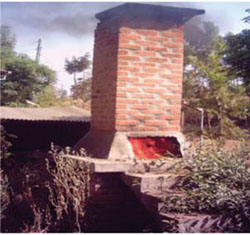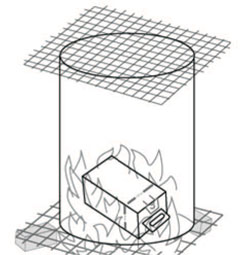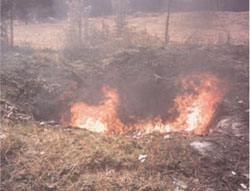7.6.2 Incineration and other methods of burning waste
Incineration means burning at very high temperatures under controlled conditions in an incinerator designed for this purpose. Incineration is a good way of disposing of waste, because it completely destroys needles, syringes, glass vials, and infectious agents by burning at very high temperatures. However, you may not have an incinerator (also known as a ‘protected hearth’) within reach of your Health Post. You could discuss the need for a proper facility for waste disposal with others in your community, such as Agricultural Extension Workers and kebele leaders. It might be possible to build an incinerator for you all to use (Figure 7.3).

Burning in a metal drum (container burning)
If you can get a suitable container such as a metallic drum with both ends removed (Figure 7.4), you can burn your medical waste in it. The drum should be placed in a fenced area that has been cleared for this purpose. Place four bricks on the ground, with spaces between them and a metal screen or grate on top. Place the open base of the drum on the metal screen and put another screen on top. The metal screens are to allow air to flow around the burning waste so the fire gets hotter, and to reduce the amount of ash flying out of the top. Put the safety boxes and some paper, dry leaves, or small sticks into the drum, sprinkle them with a small amount of kerosene (if available). Put paper under the drum, between the bricks, and set light to it so the flames rise through the metal screen.

When the waste has completely burned and everything has cooled, put on heavy protective gloves and carefully scrape out any tiny pieces remaining in the bottom of the drum. Put them in a box and carry it to the Health Post waste pit for burial (see below).
Open pit burning
Open pit burning of waste is a common practice in many rural communities (Figure 7.5). The pit should be dug at least 2 metres deep in a fenced area. The waste should be placed in a closed and sealed box, such as a safety box, to be burnt. However, the problem with this method is that unburnt pieces may be blown by the wind and scattered around the pit, or the fire may go out and not destroy some of the waste. Ideally, you should watch while the waste is burning until you can see that everything in the box has been completely burnt. When the pit is three-quarters full of burnt waste, it should be covered with a deep layer of soil and (if possible) topped with concrete. It should be clearly marked so that everyone is aware that they must not dig up the contents.

7.6.1 Safety boxes
